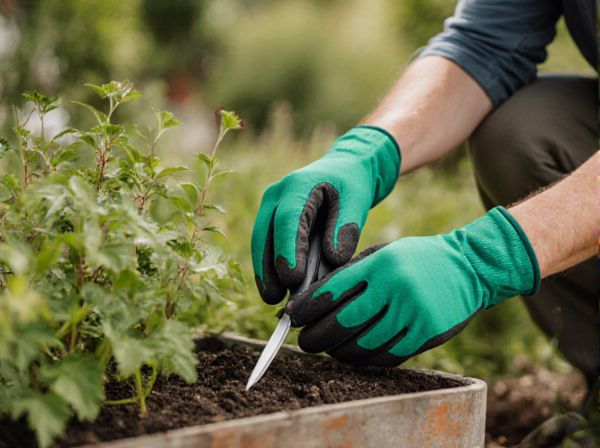
Grafting vs Seed Propagation Illustration
Grafting enables faster maturity and preserves desirable traits by joining a scion to a rootstock, ensuring genetic consistency and disease resistance. Seed propagation promotes genetic diversity and is simpler but can result in variable plant characteristics and longer growth periods. Choosing between grafting and seed propagation depends on the desired uniformity, growth speed, and plant resilience.
Table of Comparison
| Feature | Grafting | Seed Propagation |
|---|---|---|
| Definition | Joining two plant parts for growth as one | Growing plants from seeds |
| Genetic Uniformity | Clonal, identical to parent | Genetically variable |
| Growth Speed | Faster maturation | Slower development |
| Disease Resistance | Can improve resistance using rootstock | Depends on seed genetics |
| Cost | Higher initial cost | Lower cost |
| Skill Level | Requires technical skill | Simple technique |
| Reproduction Type | Asexual (vegetative) | Sexual |
| Applications | Fruit trees, ornamental plants | Annuals, wild plants, large-scale farming |
Understanding Grafting and Seed Propagation
Grafting combines the tissues of two plants to grow as one, enabling desirable traits like disease resistance and improved fruit quality to be preserved, while seed propagation relies on genetic variation and is commonly used for reproducing annual plants or hybrid varieties. Grafting requires compatible rootstock and scion, ensuring a strong vascular connection, whereas seed propagation depends on seed viability, germination rates, and environmental conditions. Understanding the differences helps growers optimize plant health, yield, and breeding strategies for crops like fruit trees and ornamentals.
Key Differences Between Grafting and Seed Propagation
Grafting involves joining tissues from two plants to grow as one, ensuring the new plant retains the exact genetic traits of the parent, unlike seed propagation which results in genetic variation. Seed propagation relies on the natural growth of a seed into a new plant, often leading to diverse characteristics and longer maturation times. Grafting accelerates plant maturity and uniformity, making it ideal for fruit trees and ornamental plants, while seed propagation is cost-effective and suited for large-scale crop production.
Advantages of Grafting in Garden Plants
Grafting in garden plants offers faster fruit production compared to seed propagation, with grafted plants often bearing fruit within one to two years. It enables the combination of superior rootstock traits, such as disease resistance and drought tolerance, with desirable fruit or flower characteristics. This propagation method ensures genetic uniformity and preserves the quality of the parent plant, which is especially beneficial for maintaining cultivars with unique attributes.
Benefits of Seed Propagation for Gardeners
Seed propagation offers gardeners genetic diversity, leading to stronger, more resilient plants adapted to local conditions. It is cost-effective and scalable for mass planting, producing root systems that better establish in soil compared to grafted plants. Growing from seed also allows gardeners to experiment with various cultivars and preserve heirloom varieties.
Ideal Plants for Grafting Techniques
Grafting is ideal for fruit trees such as apples, cherries, and citrus, as well as ornamental plants like roses and camellias, where maintaining genetic consistency and disease resistance is crucial. Unlike seed propagation, which can introduce genetic variability, grafting ensures the new plant retains the parent's desirable traits and produces faster yields. Plants with woody stems and well-developed rootstock are best suited for grafting techniques, enhancing growth vigor and environmental adaptability.
Best Plants for Seed Propagation
Tomatoes, beans, and lettuce are among the best plants for seed propagation due to their high germination rates and ease of growing from seeds. These plants develop strong root systems and exhibit genetic diversity, which enhances adaptability to various growing conditions. Seed propagation is particularly advantageous for annual vegetables and herbs, ensuring rapid growth and abundant yield.
Grafting Methods: Step-by-Step Guide
Grafting methods involve joining the tissues of two plants so they grow as one, enhancing desired traits like disease resistance or fruit quality. The step-by-step process begins with selecting compatible rootstock and scion, followed by making precise cuts on both parts to ensure tight contact. Securing the graft union with tape or grafting clips and maintaining optimal humidity promotes successful healing and growth.
Seed Propagation Process: Essential Tips
Seed propagation involves selecting high-quality, disease-free seeds to ensure robust plant growth. Proper soil preparation, including adequate drainage and nutrient balance, is crucial for seed germination success. Maintaining consistent moisture and optimal temperature supports healthy seedling development and increases overall propagation efficiency.
Common Challenges in Grafting and Seed Propagation
Grafting faces common challenges such as incompatibility between rootstock and scion, risk of infection at the graft union, and environmental stress affecting successful union. Seed propagation often encounters issues like low germination rates, seed dormancy, and vulnerability to soil-borne diseases. Both methods demand precise conditions to maximize plant growth and yield.
Choosing the Right Propagation Method for Your Garden
Grafting offers precise control over plant traits by combining the best qualities of rootstock and scion, ideal for fruit trees and roses where uniformity and disease resistance matter. Seed propagation promotes genetic diversity and is cost-effective, suitable for annuals and wildflowers that thrive from natural variation. Selecting the right method depends on the plant species, desired growth characteristics, and long-term garden goals.
Grafting vs Seed Propagation Infographic

 gardendif.com
gardendif.com